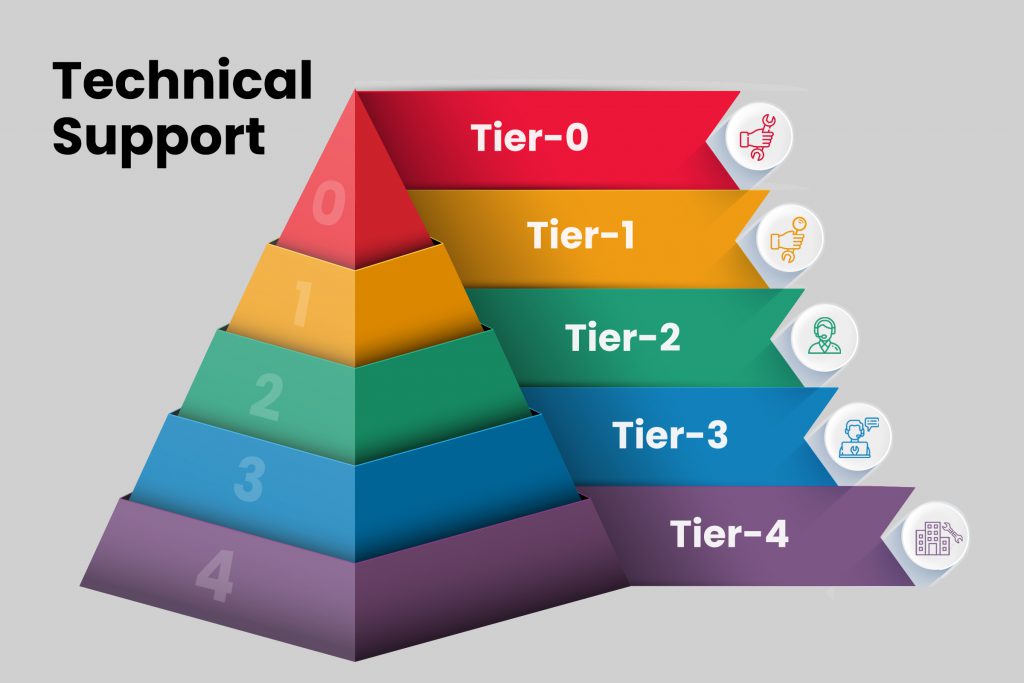Tech support for small businesses helps improve customer experience as these professionals provide support to customers, clients, and even employees who encounter issues with hardware and software used in the business. Their scope of work is broad, and the type of freelance technical support that you hire depends on the support tier that you need them to fulfill. Typically, they’re organized into five levels: pre-support and levels zero through four, with the complexity of work increasing as the level goes higher. With this organization, you can distinguish the different types of technical support, from help desk staff to product or technical support to experts and developers.
What Is Technical Support?
Before we go into the levels and types, we must first understand the job description of tech support workers. Tech support specialists oversee, maintain, and repair a company’s hardware and software systems. They particularly handle and resolve IT-related support tickets requested internally and externally.
Types of Technical Support
Technical support specialists often have a wide knowledge of IT and computer concepts, matched by exceptional technical abilities and customer service skills. That said, the job is often organized into tiers that define their scope of work, particularly the complexity of the issues that they would handle.
Here are the types of technical support by level:
Pre-Support
Pre-support is a level that doesn’t require any technical support specialist. It’s a sort of self-service done by customers or employees themselves. That is, when a problem arises, it can be resolved solely by the user, typically through stock knowledge, innate technical know-how, or a quick Google search.
Tier 0
Tier 0 also relies on self-help and user-retrieved information. But unlike pre-support, the solutions are taken from within the business’s resources, including FAQs, detailed product info sheets, blog posts, search functions, and user forums. This level of support is created by the business’s tech support, typically with the marketing and development teams, and is usually updated regularly or maintained by a moderator.
Tier 1
Tier 1 is where the actual tech support comes in. This tier involves basic help desk resolution and delivery accomplished by lower-level technical personnel who are trained to solve common problems and fulfill service requests by following scripts.
Issues in this tier include troubleshooting usage problems such as log-ins, website navigation, set-up, etc. It doesn’t necessarily require personnel with complex computer science knowledge; often, just a basic understanding of the products and services of the business will do.
Tier 2
When issues can’t be resolved in pre-support, Tier 0, or Tier 1, they’re escalated to Tier 2 where tech support specialists with deep knowledge of the product or service are ready to resolve the problem. At this level, technicians review the request from Tier 1, assessing the validity of the issue and the steps already taken before coming up with a different solution using advanced technical troubleshooting and analysis methods.
Tier 3
When Tier 2 is unable to solve a technical problem, the issue is elevated to Tier 3, which is made up of the company’s most highly skilled product specialists. This tier often includes the creators, chief architects, developers, or engineers who created the product or service and can, therefore, identify the root of complex issues and provide solutions accordingly (which may even involve creating new features).
Tier 3 technicians use product design, code, or specification to duplicate problems and define root causes and decide how to fix them from there. Once a solution is developed, this is documented for use by tech support in the lower tiers.
Tier 4
Not all companies employ a Tier 4 support level as this refers to outside support for issues not supported by the organization, i.e. out of your tech support team’s jurisdiction. For example, if a customer or employee faces issues with hardware or software from another company (e.g. a machine that you bought or third-party software that you installed), then they can bring up the issue with you, but then this will be redirected to the outsourced service and will only be monitored by your for implementation.
Why Is Technical Support Important?
Technical support is important both internally and externally. Having tech support for your business allows employees to be more productive by ensuring that there are no errors or issues that can hamper their workflow. With tech support specialists’ recommendations, work processes may even be improved.
Tech support also improves the customer experience as it allows users and clients to navigate and use your products and services without any complications..
How to Find the Right Technical Support
In this digital age where everyone relies on technology for everything, tech support is an essential part of every business. Finding the right one for you is easy through Guru, where you can find thousands of freelance tech support specialists who can add value to your company by improving internal and external user experience.



